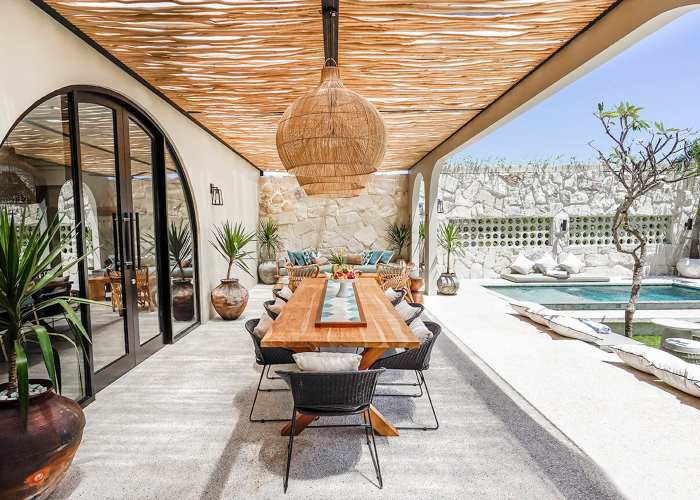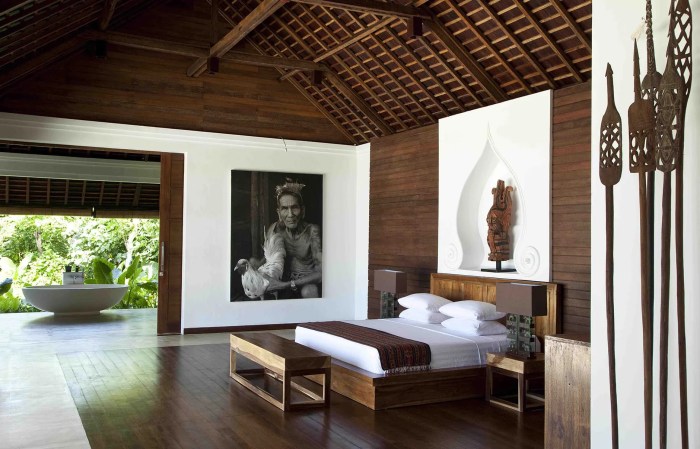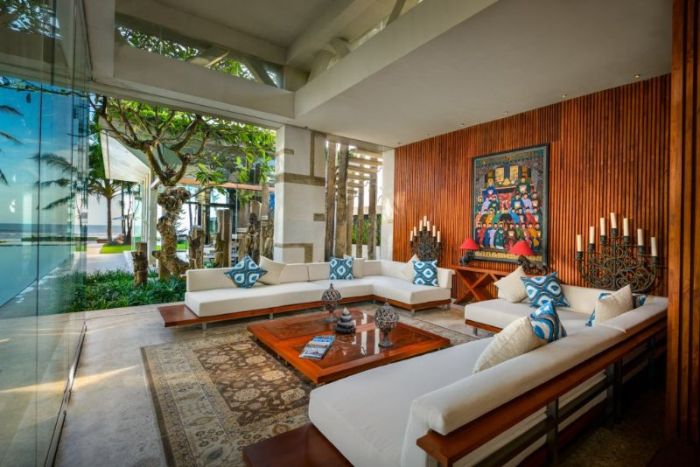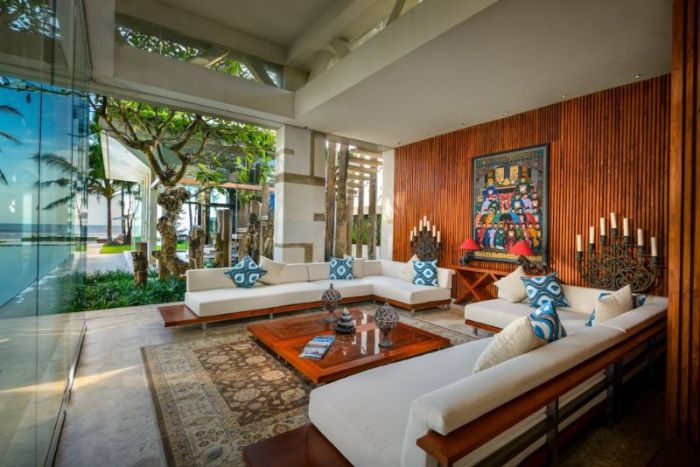Bali house interior design is more than just a style; it’s a philosophy of living in harmony with nature. Imagine stepping into a home where warm sunlight filters through intricately carved wooden screens, the air is infused with the scent of frangipani, and every detail whispers of ancient traditions and modern comfort.
This is the essence of Balinese interior design, where natural materials, vibrant colors, and a deep respect for the environment come together to create spaces that are both visually stunning and deeply relaxing.
This guide explores the diverse world of Balinese interior design, delving into its history, key elements, and modern interpretations. We’ll uncover the secrets behind the captivating color palettes, the unique furniture pieces, and the thoughtful use of natural light and materials that define this distinct style.
Whether you’re dreaming of a tranquil retreat or seeking inspiration for your next design project, this exploration of Balinese interiors promises to be a journey of discovery and inspiration.
Color Palette and Materials
A Balinese home interior is a symphony of colors and textures, drawing inspiration from the island’s lush landscapes and vibrant culture. The color palette and materials used in Balinese interior design are carefully chosen to create a sense of harmony, tranquility, and connection with nature.
Color Palette
The color palette for a Balinese home interior typically features earthy tones, natural hues, and vibrant accents. * Earthy Tones:These colors are inspired by the island’s volcanic soils, sandy beaches, and lush vegetation. Common earthy tones include:
Warm browns
These colors evoke a sense of grounding and stability, reminiscent of rich soil and aged wood.
Creamy beige
This color is reminiscent of the island’s sandy beaches and creates a feeling of calm and serenity.
Olive green
This color is inspired by the island’s abundant vegetation and brings a sense of freshness and vitality.* Natural Hues:These colors are inspired by the island’s natural elements, such as water, sky, and sunlight. Common natural hues include:
Soft blues
Bali house interior design often incorporates natural materials and earthy tones, creating a sense of tranquility and connection to nature. For smaller spaces, you can draw inspiration from this style, even if you’re working with a limited footprint. If you’re designing a 550 sq ft house, you might find some useful tips and ideas in this article on 550 sq ft house interior design.
By using clever storage solutions and maximizing natural light, you can create a calming and functional space that reflects the essence of Bali house design, regardless of the size of your home.
These colors evoke a sense of peace and tranquility, reminiscent of the clear blue sky and ocean waters.
Pale yellows
These colors bring a sense of warmth and brightness, reminiscent of the golden sunlight that bathes the island.
Subtle pinks
These colors add a touch of romance and femininity, inspired by the island’s vibrant flowers.* Vibrant Accents:These colors add pops of energy and personality to the interior. Common vibrant accents include:
Red
This color symbolizes passion, energy, and good luck in Balinese culture.
Orange
This color represents joy, creativity, and abundance.
Yellow
This color is associated with wisdom, knowledge, and enlightenment.
Materials
The materials used in Balinese interior design are carefully chosen to complement the color palette and create a warm, inviting atmosphere. Common materials include:* Wood:Wood is a staple material in Balinese interior design, used for everything from furniture and flooring to ceilings and walls.
The most common types of wood used include:
Teak
Known for its durability, rich color, and beautiful grain, teak is often used for furniture, doors, and window frames.
Jati
This type of wood is similar to teak in terms of durability and color, and is often used for flooring and furniture.
Merbau
This reddish-brown wood is known for its strength and resistance to moisture, making it ideal for outdoor furniture and flooring.* Stone:Stone is another important material used in Balinese interior design, often used for flooring, walls, and decorative elements. Common types of stone include:
Volcanic rock
This type of stone is commonly found on the island and is often used for walls, pathways, and decorative features.
Coral stone
This type of stone is known for its unique texture and porous nature, making it ideal for walls and decorative elements.
Limestone
This type of stone is often used for flooring and walls, creating a sense of elegance and sophistication.* Bamboo:Bamboo is a versatile material that is widely used in Balinese interior design, particularly for furniture, lighting fixtures, and decorative elements.
Split bamboo
Bali house interior design often evokes a sense of tranquility and connection to nature, with its use of natural materials, earthy tones, and open spaces. This style can be seen as a modern interpretation of traditional Balinese architecture, drawing inspiration from the island’s rich cultural heritage.
You might be surprised to find that some of the design elements commonly found in Bali homes, such as rattan furniture and geometric patterns, are also reminiscent of 60s house interior design , which embraced a similar sense of simplicity and functionality.
This shared aesthetic highlights the enduring appeal of timeless design principles that transcend generations and cultural boundaries.
This type of bamboo is often used for furniture and decorative elements, creating a rustic and natural look.
Round bamboo
This type of bamboo is often used for furniture, walls, and ceilings, adding a touch of elegance and sophistication.* Rattan:Rattan is a type of vine that is often used for furniture, baskets, and decorative elements. It is known for its strength, flexibility, and natural beauty.
Natural rattan
This type of rattan is often used for furniture, baskets, and decorative elements, creating a rustic and natural look.
Woven rattan
This type of rattan is often used for furniture and decorative elements, adding a touch of elegance and sophistication.
| Material | Type | Properties | Applications |
|---|---|---|---|
| Wood | Teak | Durable, rich color, beautiful grain | Furniture, doors, window frames |
| Wood | Jati | Durable, similar to teak in color | Flooring, furniture |
| Wood | Merbau | Strong, resistant to moisture | Outdoor furniture, flooring |
| Stone | Volcanic rock | Commonly found on the island | Walls, pathways, decorative features |
| Stone | Coral stone | Unique texture, porous nature | Walls, decorative elements |
| Stone | Limestone | Elegant, sophisticated | Flooring, walls |
| Bamboo | Split bamboo | Rustic, natural look | Furniture, decorative elements |
| Bamboo | Round bamboo | Elegant, sophisticated | Furniture, walls, ceilings |
| Rattan | Natural rattan | Rustic, natural look | Furniture, baskets, decorative elements |
| Rattan | Woven rattan | Elegant, sophisticated | Furniture, decorative elements |
Furniture and Decor

Balinese interior design emphasizes natural materials, intricate craftsmanship, and a harmonious connection with nature. This is reflected in the choice of furniture and decorative elements, which often feature traditional designs and motifs.
Traditional Furniture
Traditional Balinese furniture is known for its simplicity, functionality, and aesthetic appeal. It is typically made from natural materials such as wood, bamboo, and rattan, and often features intricate carvings and woven patterns.
- Beds:Balinese beds, known as “tempat tidur,” are often made from wood and feature a simple, rectangular frame with a low headboard. They may be adorned with carvings or painted with traditional motifs.
- Chairs:Traditional Balinese chairs, known as “kursi,” come in various styles, including low stools, high-backed chairs, and rocking chairs. They are often made from wood or bamboo and may feature intricate carvings or woven patterns.
- Tables:Balinese tables, known as “meja,” are typically made from wood and feature a simple, rectangular or round top. They may be adorned with carvings or painted with traditional motifs.
Handcrafted Furniture and Artwork
Balinese artisans are renowned for their skill in creating handcrafted furniture and artwork. They use traditional techniques and materials to create unique pieces that reflect the island’s rich cultural heritage.
- Carved Wooden Furniture:Balinese woodcarvers use various techniques to create intricate designs on furniture pieces. These designs often depict religious figures, mythical creatures, or floral motifs.
- Woven Rattan Furniture:Rattan is a durable and flexible material that is commonly used to create furniture pieces. Balinese artisans weave rattan into various patterns to create chairs, tables, and other pieces.
- Traditional Paintings:Balinese paintings, known as “wayang,” often depict scenes from Hindu mythology or everyday life. They are typically painted on cloth or paper using natural pigments.
Essential Decorative Elements
Decorative elements play a crucial role in creating a Balinese ambiance. These elements often feature traditional designs and motifs and are made from natural materials.
- Sculptures:Balinese sculptures, known as “patung,” often depict Hindu deities, mythical creatures, or everyday objects. They are typically made from wood, stone, or metal.
- Paintings:Balinese paintings, known as “wayang,” often depict scenes from Hindu mythology or everyday life. They are typically painted on cloth or paper using natural pigments.
- Textiles:Balinese textiles, known as “kain,” are often woven with intricate patterns and designs. They are used to create curtains, wall hangings, and other decorative elements.
- Lighting Fixtures:Balinese lighting fixtures often feature traditional designs and are made from natural materials such as bamboo, rattan, or wood. They may be adorned with carvings or woven patterns.
Lighting and Natural Elements

A Balinese home is not just a space to live in; it’s an extension of nature itself. The design philosophy emphasizes a seamless connection between the interior and exterior, with natural light playing a crucial role in creating a welcoming and serene atmosphere.
Natural Light and Artificial Lighting
Natural light is essential in a Balinese home, and the design should maximize its use. Large windows, open-air courtyards, and skylights allow ample sunlight to flood the interior. However, strategically placed artificial lighting fixtures are also necessary to provide ambiance and functionality during the evenings and in darker areas.
- Natural Light:Large windows, open-air courtyards, and skylights are used to allow natural light to flood the interior. This creates a bright and airy feel, and helps to connect the home with the surrounding environment.
- Artificial Lighting:Artificial lighting is used to supplement natural light, particularly in the evenings and in darker areas. The focus is on creating a warm and inviting atmosphere, with soft, diffused light.
- Types of Lighting:
- Ambient Lighting:Provides general illumination throughout the space.
- Task Lighting:Provides focused light for specific activities, such as reading or working.
- Accent Lighting:Highlights specific features, such as artwork or sculptures.
- Lighting Fixtures:
- Pendant Lights:Create a dramatic and elegant focal point.
- Wall Sconces:Offer a soft and diffused light, ideal for creating a cozy atmosphere.
- Floor Lamps:Provide a flexible and adjustable light source.
- Types of Lighting:
Incorporating Natural Elements
Incorporating natural elements is a cornerstone of Balinese design, creating a harmonious connection between the home and the surrounding environment. Plants, water features, and outdoor spaces are seamlessly integrated into the interior design, bringing a sense of tranquility and serenity.
- Plants:Plants are essential in Balinese homes, symbolizing life, growth, and prosperity. They purify the air, create a calming atmosphere, and bring a touch of nature indoors.
- Indoor Plants:Orchids, ferns, and bamboo plants are popular choices, adding a touch of tropical elegance.
- Outdoor Plants:Palm trees, frangipani, and bougainvillea are commonly used to create a lush and tropical landscape.
- Water Features:Water is a sacred element in Balinese culture, representing purity and tranquility. Water features, such as fountains, ponds, and waterfalls, are incorporated into the design to create a soothing and calming atmosphere.
- Outdoor Spaces:Balinese homes often feature outdoor spaces, such as courtyards, patios, and balconies, that are designed to extend the living area and provide a connection with nature.
Traditional Balinese Lighting Techniques, Bali house interior design
Traditional Balinese lighting techniques utilize natural materials and create a warm and inviting ambiance. Oil lamps and lanterns, made from materials like bamboo, clay, and coconut shells, are often used for both practical and decorative purposes.
- Oil Lamps:These lamps are made from clay or coconut shells and are filled with oil, typically coconut oil, and a wick. They provide a soft, flickering light, creating a romantic and traditional atmosphere.
- Lanterns:Lanterns are often made from bamboo or woven materials and are decorated with intricate carvings or patterns. They are used to create a warm and inviting ambiance, particularly in outdoor spaces.
Balinese Architecture and Space Planning: Bali House Interior Design

Balinese architecture is deeply rooted in the island’s natural environment and spiritual beliefs, emphasizing a harmonious connection between the built environment and the surrounding landscape. This approach is evident in the use of open spaces, courtyards, and natural ventilation, which create a sense of serenity and connection to the natural world.
Key Principles of Balinese Architecture
Balinese architecture is characterized by its emphasis on open spaces, courtyards, and natural ventilation, which are designed to promote a sense of harmony and connection with the natural world.
- Open Spaces and Courtyards:Balinese homes often feature open spaces and courtyards that serve as central gathering areas and provide natural light and ventilation. These spaces are typically surrounded by lush vegetation and water features, creating a tranquil and inviting atmosphere.
- Natural Ventilation:Balinese architecture emphasizes natural ventilation through the use of open spaces, high ceilings, and strategically placed windows and doors. This allows for a constant flow of fresh air, creating a comfortable and healthy living environment.
- Integration with Nature:Balinese homes are designed to blend seamlessly with their natural surroundings, incorporating elements like bamboo, wood, and stone into the construction. This integration with nature creates a sense of harmony and tranquility.
- Spiritual Significance:Balinese architecture is deeply rooted in the island’s spiritual beliefs, with many elements symbolizing the interconnectedness of life and the importance of balance. For example, the use of a “meru” (temple-like structure) in the center of the courtyard represents the sacred mountain of Mount Agung, which is considered the spiritual heart of Bali.
Bali house interior design often incorporates natural elements like bamboo and wood, creating a relaxed and welcoming atmosphere. If you’re working with a smaller space, like a 1200 sq ft house, you can still achieve a similar aesthetic by incorporating these elements in a more compact way.
1200 sq ft house interior design often focuses on maximizing space and using light colors to create a sense of openness. By drawing inspiration from Bali’s design principles, you can transform even a smaller space into a serene and inviting sanctuary.
Balinese Home Floor Plan
This floor plan incorporates traditional architectural elements and space planning principles to create a harmonious and functional Balinese home.
- Central Courtyard:The heart of the home is a spacious courtyard, surrounded by verandahs and open-air living spaces. This courtyard serves as a gathering place for family and guests and provides natural light and ventilation to the surrounding rooms.
- Verandahs and Open-Air Living Spaces:The home features verandahs and open-air living spaces that blur the boundaries between the indoors and outdoors. These spaces are ideal for relaxation, dining, and enjoying the natural beauty of the surroundings.
- Bedrooms:Bedrooms are typically located on the periphery of the courtyard, offering privacy and tranquility. They often feature traditional Balinese furniture and decor, creating a serene and welcoming atmosphere.
- Kitchen and Dining Area:The kitchen and dining area are located near the courtyard, allowing for easy access to fresh air and natural light. These spaces are typically designed with a focus on functionality and aesthetics.
- Temple or Prayer Room:A small temple or prayer room is often incorporated into the home, reflecting the importance of spirituality in Balinese culture.
Types of Balinese Houses
Different types of Balinese houses have evolved over time, each with its unique characteristics and floor plan layouts.
| Type of House | Typical Floor Plan Layout | Characteristics |
|---|---|---|
| Traditional Balinese House (Lumbung) |
|
|
| Modern Balinese House |
|
|
| Villa |
|
|
Closure
From the serene beauty of traditional Balinese homes to the contemporary interpretations that blend modern aesthetics with ancient wisdom, Balinese interior design offers a unique and timeless approach to creating spaces that are both visually appealing and spiritually enriching. By embracing the principles of natural materials, vibrant colors, and mindful space planning, you can infuse your own home with the tranquility and elegance of Bali, creating a sanctuary that nourishes the soul and invites you to embrace a life of balance and beauty.
FAQ Insights
What are the most popular Bali house interior design styles?
The most common styles are traditional Balinese, modern Balinese, and contemporary Balinese. Each style features distinct characteristics, from intricate carvings and natural materials in traditional designs to minimalist aesthetics and modern furniture in contemporary styles.
How can I incorporate Balinese design elements into my own home?
Start by introducing natural materials like bamboo, rattan, and wood. Incorporate earthy tones and vibrant accents into your color palette. Consider adding traditional Balinese furniture pieces or incorporating decorative elements like sculptures, paintings, and textiles. Even adding a few plants or a water feature can bring a touch of Balinese serenity to your space.
Where can I find Balinese furniture and decor?
Many online retailers specialize in Balinese furniture and decor. You can also find handcrafted items at local artisan markets or through online platforms that support fair trade practices.

